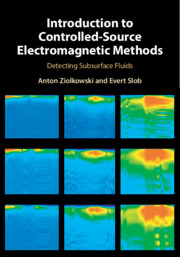
-
Select format
-
- Publisher:
- Cambridge University Press
- Publication date:
- 16 April 2019
- 07 March 2019
- ISBN:
- 9781107415904
- 9781107058620
- Dimensions:
- (247 x 174 mm)
- Weight & Pages:
- 0.83kg, 332 Pages
- Dimensions:
- Weight & Pages:
You may already have access via personal or institutional login
Book description
This volume describes how controlled-source electromagnetic (CSEM) methods are used to determine the electrical conductivity and hydrocarbon content of the upper few kilometres of the Earth, on land and at sea. The authors show how the signal-to-noise ratio of the measured data may be maximised via suitable choice of acquisition and processing parameters and selection of subsequent data analysis procedures. Complete impulse responses for every electric and magnetic source and receiver configuration are derived, providing a guide to the expected response for real data. 1-D, 2-D and 3-D modelling and inversion procedures for recovery of Earth conductivity are presented, emphasising the importance of updating model parameters using complementary geophysical data and rock physics relations. Requiring no specialist prior knowledge of electromagnetic theory, and providing a step-by-step guide through the necessary mathematics, this book provides an accessible introduction for advanced students, researchers and industry practitioners in exploration geoscience and petroleum engineering.
Contents
Metrics
Altmetric attention score
Full text views
Full text views help Loading metrics...
Loading metrics...
* Views captured on Cambridge Core between #date#. This data will be updated every 24 hours.
Usage data cannot currently be displayed.
Accessibility standard: Unknown
Why this information is here
This section outlines the accessibility features of this content - including support for screen readers, full keyboard navigation and high-contrast display options. This may not be relevant for you.
Accessibility Information
Accessibility compliance for the PDF of this book is currently unknown and may be updated in the future.


